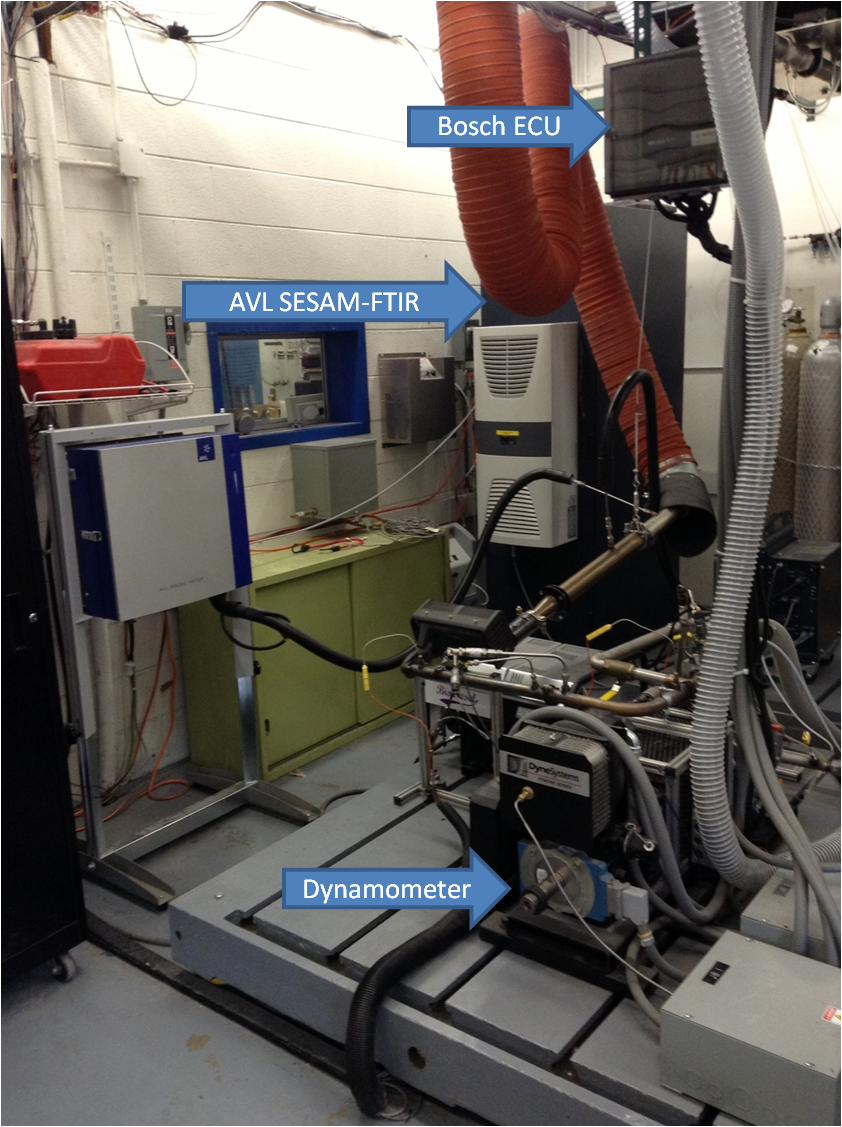Single-Cylinder Engine Test Cell
Upon starting at KU in 2008, Prof. Depcik began the implementation of a single-cylinder engine test cell that is now operational. A single-cylinder engine removes the non-linearity of fluid dynamics and heat transfer that occurs with multi-cylinder engines, thus allowing better identification of trends and kinetic studies. This engine, a Yanmar L100V, has undergone a number of upgrades including: an Alternating Current (AC) dynamometer for engine loading and motoring studies, a Variable-Geometry Turbocharger, gaseous-additive fuel injection system, external cooled and self-regulated EGR system, in-cylinder pressure measurement, and electronically controlled common-rail fuel injection system allowing for up to five injections per thermodynamic cycle. The combination of in-cylinder pressure measurement and electronic injection allows optimization of the combustion and emissions based on desired speed, load, EGR, boost, and multiple fuel characteristics. The emissions measurement capabilities allow researchers to observe the influence of various engine operation techniques on exhaust composition using an AVL FTIR and particulate sampling AVL Smoke Meter. Measurement of all available performance metrics is performed using custom LabVIEW programs written in-house by graduate students. In total, three systems are required to collect the necessary data. This includes a low-speed (10Hz) system for intake, fuel, torque, and exhaust characteristics, a high-speed system (43kHz) for in-cylinder pressure and engine crank angle for heat release analysis, and an emissions recording system that communicates with the FTIR and Smoke Meter. Finally, recent efforts in Prof. Depcik's laboratory involve the creation of a heat release program that can provide temperature profiles, determine ignition delay, and delineate between premixed and diffusion combustion phases. Using this engine, Prof. Depcik and his students have been able to publish multiple papers in high impact journals investigating conventional petroleum fuel, jet fuel, biodiesel, renewable jet fuel, and gas-assisted liquid fuels combustion.
Representative paper: Exergy Analysis of Dual-Fuel Operation with Diesel and Moderate Amounts of Compressed Natural Gas in a Single-Cylinder Engine - doi: 10.1080/00102202.2017.1399882
 |
 |
Single-cylinder engine test cell highlighting the different systems
| Engine | 5 kW Yanmar L100V diesel (YDG5500EV-6EI); air cooled, 435 cc, two-valve, 86 mm bore, 75 mm stroke, compression ratio of 21.2, estimated maximum pressure of 70 bar. |
| In-Cylinder Pressure Analysis | Kistler 6052C piezoelectric transducer calibrated to measure from 0 to 250 bar with less than 0.5% error at up to 160 kHz; Sensitivity to thermal shock less than 0.5 bar; Kistler 5011B charge amplifier with low-pass filter; Kistler 2614B encoder and Kister 2614B4 pulse multiplier provides range of 0.1⁰ to 6⁰ resolution; Dedicated computer with terra-byte of storage; National Instruments PCIe-7841R with Field-Programmable Gate Array (FPGA) chip that has the capability to perform sampling up to 200 kHz exceeding the rate of the pressure transducer. |
| Dynamometer | DyneSystems 12 hp/21.1 ft-lbs max regenerative air-cooled Alternating Current dynamometer (0-7500 rpm); steady-state and transient testing capabilities; DyneSystems Inter-Loc V multi-loop controller and operator control station. |
| Fuel Injection | Bosch CP3.2 high pressure fuel pump; MS15.1 Diesel Electronic Control Unit; Rail system with pressure control valve (DRV), limiting valve (DBV) and sensor (RDS); Fiat Grande Punto MJTD 1.3L bar injector machined to fit Yanmar head; MSA2 box-cal interface. |
| Gaseous-Assisted Fuel Injection | Stainless steel regulator (Linweld model #CGA-350) releases gas at 50 psi required for Brooks thermal mass flow controller (model #SLA5850S). Data collection and flow verification employs two type K thermocouples and two pressure transducers (Omega model #PX329). Gas added upstream of intake via a mixing box. Flame arrestor located on outlet of flow controller. |
| Automated Cooled EGR | EGR monitored using two K-33 ICB CO2 Sensor Development Kits (CM-0027), two Sensor Pump Kits (CM-0111), two Water Traps (CM-0112), and micron Particulate Filters (CM-0117); CO2 measured in the intake (not found in intake without EGR) and exhaust create a dilution ratio for EGR measurement; high temperature valves adjust EGR flow; custom heat exchanger (Alturdyne NSN #2930-01-156-8665, two 12 VDC cooling fans; Scythe model #DFS123812H) cools EGR before entering intake; RTDs before and after heat exchanger will monitor cooling efficiency. Parallax (Propeller model #P8X32A), stepper motors, and power supplies used with LabVIEW program to dynamically control EGR levels. |
| Turbocharger | Aerocharger 53-series trimmed for 136 cfm; variable vane; ceramic ball bearings and self-contained lubrication. |
| General Measurement | Equipped with sensors to monitor ambient air temperature, pressure, and relative humidity, engine intake air temperature and pressure, exhaust port temperature, downstream exhaust temperature and pressure; Micro-Motion Coriolis flow meter (model CMF010M) for fuel flow and density measurements; FUTEK rotary torque-sensor (model TRS605) connected between the engine and dynamometer; Engine intake airflow measurements via a Merriam laminar flow element (model 50MW20-2) and Omega differential pressure transducer (model PX277-30D5V); Remaining parameters acquired using appropriate Omega pressure and temperature sensors. |
| Data Acquisition | National Instruments (NI) compact-Reconfigurable Input/Output (cRIO) device (model cRIO-9014) operating in conjunction with a LabVIEW program designed and coded in-house. |
| Emissions Analyzer #1 | Semtech-D (Sensors, Inc) measures CO and CO2 using non-dispersive IR spectroscopy, NO and NO2 by non-dispersive UV spectroscopy, and total hydrocarbons by flame ionization detection; Inline electronic flowmeter provides second-by-second mass emissions data; Dekati Low-Pressure Impactor provides collection of particulate matter in 13 size fractions ranging from 10um to 30 nm. |
| Emissions Analyzer #2 | AVL SESAM-FTIR 2030HY measures CO2, CO, NO, NO2, H2O, N2O, CH4, NH3, HNCO, HCN, HCHO, CH3CHO, AHC, C2H2, C2H4, C2H6, C3H6, C3H8, C4H6 and SO2; AVL paramagnetic detector for O2 and flame ionization detector for THC. |
| Emissions Analyzer #3 | AVL Smoke Meter 415SE measures soot content using filter paper method resulting in Filter Smoke Number (ISO 10054); low detection limit of 0.002 FSN. |
